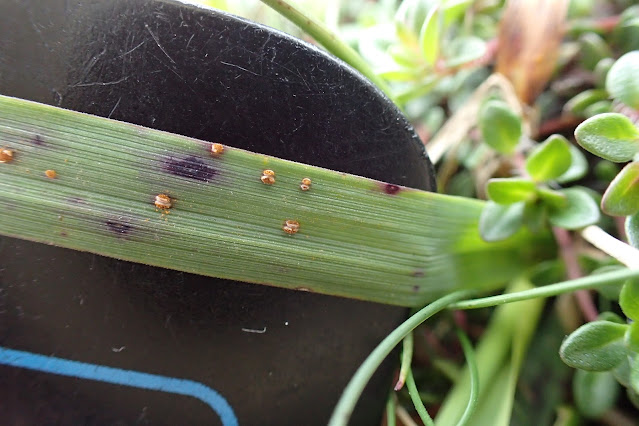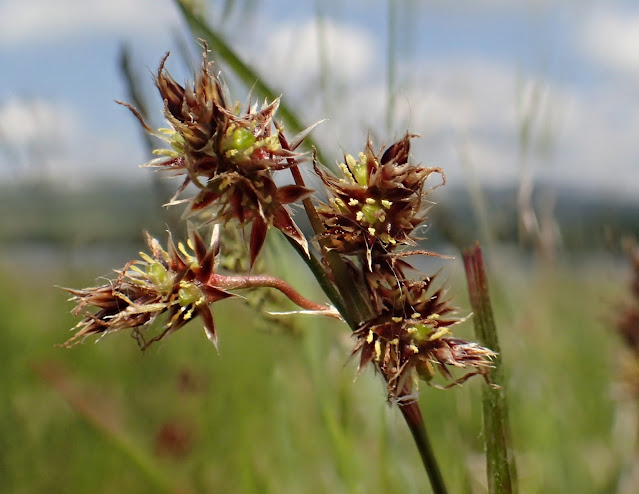I could write 100 posts about this walk on Sat 24 May 2024...
 |
| Bird's-eye-primrose |
But would you or anyone listen that long?
So this post is confined to a 10m by10m (maybe 15m by 15m) area of short limestone grassland turf in Malham Lings - an island surrounded by acid grassland.
My Settle Lockdown Walks (1 to 129) only extended to easy walking distance from Settle and Langcliffe. Malham Tarn, 6 miles away as the curlew flies was too far for me to visit during lockdown.
But I once lived for eight years at Malham Tarn House and have visited the Estate every year since. So how can I not include a post about this area? Whilst working at the centre I recorded 400 higher plant species on the Estate. They were nearly all (but not quite all) wild. There is such a variety of habitats.
Sadly the Field Studies Council stopped the Field Centre two years ago. So people cannot attend Field Courses there any more, and the community that lived there is gone. The National Trust own the property and Estate. The Estate and area is a Site of Special Scientific Interest, a National Nature Reserve, a Ramsar Site (Wetlands). The National Trust had staff who have managed the nature reserve for many years, and they are still here, doing a good job. Thank you to them.
Today's walk, is c 1 mile from the Car Park near the south end of the Tarn round the east side of the Tarn through the wood up to the House. Then back.
- Car park (7 cars including mine at 9am; Jam packed - maybe 30 cars at 1.30pm, so that there was no space for more cars.)
- Wet parts of Malham Lings
- Dry higher areas - acid grassland
- Dry higher areas- grassland on moraine made from limestone rocks and gravel
- Ha Mire wetland - a host of NVC types - much of it M10- lime rich seepage water
- The tarn shore
- The woodland at Malham Tarn House
- Malham Tarn House Rockery and Lawn.
I could include photos of - Fungus (St George's) Lichens on trees (Xanthoria polycarpa), Lichens on Lichens on rocks: (Toniniopsis verrucarioides) Millipede, Red what I call money spider, Moth/fungus gnat... maybe I'll put them on another post later..
and flowers.
For this post I will restrict myself to SD89676616 - An un-pretentious mound of limestone grassland - in Malham Lings, surrounded by acid grassland. . It is crossed by the most direct footpath from the Water Sinks car park to Ha Mire Gate. There are several footpaths, and the Pennine Way footpath as marked on the OS map passes just over 100 m north and west of my footpath.
Many when teaching a "Flowers of the Limestone" course we had sat down and rested on this mound. I an the c 12 adult participants. - It does have good views. And lovely tiny lime-loving plants. Wild Thyme and Salad Burnet. And I discovered Mountain Everlasting flower AKA Cat's-ear - Antenaria dioica here. And Selaginella. I have looked for the Mountain Everlasting several times since but not found it recently.
So wanted to give the mound a thorough search.
I placed my rucksack down carefully next to a Selaginella selaginoides-Lesser Clubmoss plant and then spotted a tiny Twaeblade. - never seen that here before. I crawled around, the skylarks twittering above, the sun disappearing behind clouds and reappearing again. There were some delightful lime yellow tiny dandelions, with narrow ray florets giving a "Chrysanthemum Fountain Firework" effect to the whole head. Plus one more ordinary dandelion.
When I came home I looked at my photos and added in several species I had not noticed when there.
My total score was 43. 28 of them in flower, 15 not. (Though a purist might have said some of the edge species were in slightly different habitats, such as the Heath Milkwort and the Heath Woodrush) The 43 plants did include 6 grasses, 3 sedges, and the club moss.
 |
| Special Dandelion |
 |
| Special Dandelion See the bud at the right foreground. |
 |
| Mountain Everlasting. |
Well that will do for today.






















No comments:
Post a Comment